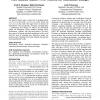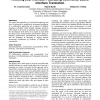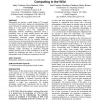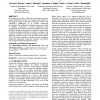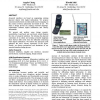ACMDIS
2006
ACM
14 years 5 months ago
2006
ACM
This paper presents the main results of a three-year long field and design study of proactive information technology in the home. This technology uses sensors to track human activ...
ACMDIS
2006
ACM
14 years 5 months ago
2006
ACM
Our physical bodies play a central role in shaping human experience in the world, understanding of the world, and interactions in the world. This paper draws on theories of embodi...
ACMDIS
2006
ACM
14 years 5 months ago
2006
ACM
We explore the application of a wiki-based technology and style of interaction to enabling the incremental translation of a collaborative application into a number of different la...
ACMDIS
2006
ACM
14 years 5 months ago
2006
ACM
ACMDIS
2006
ACM
14 years 5 months ago
2006
ACM
Automatic capture technology could enable students to record and index much information—both digital and nondigital—with little extra effort. Can this technology be designed t...
ACMDIS
2006
ACM
14 years 5 months ago
2006
ACM
Ethnography has become a staple feature of IT research over the last twenty years, shaping our understanding of the social character of computing systems and informing their desig...
ACMDIS
2006
ACM
14 years 5 months ago
2006
ACM
In this paper we describe a collaborative environment created to support distributed evaluation of a complex system architecture. The approach couples an interactive architecture ...
ACMDIS
2006
ACM
14 years 5 months ago
2006
ACM
In the excitement of the cognitive revolution, Simon proposed a way of thinking about design that promised to make it more manageable and cognitive: to think of design as a planni...
ACMDIS
2006
ACM
14 years 5 months ago
2006
ACM
People often use powerful tools to manage the documents they encounter, but very rarely to store the mental knowledge they glean from those documents. Popcorn is a personal knowle...
ACMDIS
2006
ACM
14 years 5 months ago
2006
ACM
Sensorial interfaces are based on augmenting existing physical objects with digital information. We propose sensorial activity theory to relate mu...

